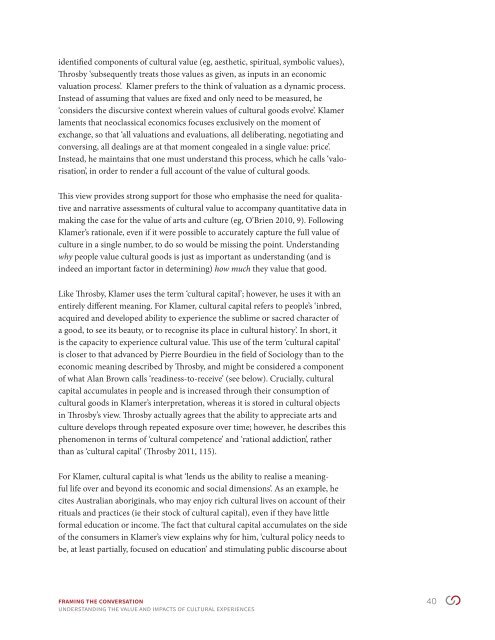aceUVi
aceUVi
aceUVi
Create successful ePaper yourself
Turn your PDF publications into a flip-book with our unique Google optimized e-Paper software.
identified components of cultural value (eg, aesthetic, spiritual, symbolic values),<br />
Throsby ‘subsequently treats those values as given, as inputs in an economic<br />
valuation process’. Klamer prefers to the think of valuation as a dynamic process.<br />
Instead of assuming that values are fixed and only need to be measured, he<br />
‘considers the discursive context wherein values of cultural goods evolve’. Klamer<br />
laments that neoclassical economics focuses exclusively on the moment of<br />
exchange, so that ‘all valuations and evaluations, all deliberating, negotiating and<br />
conversing, all dealings are at that moment congealed in a single value: price’.<br />
Instead, he maintains that one must understand this process, which he calls ‘valorisation’,<br />
in order to render a full account of the value of cultural goods.<br />
This view provides strong support for those who emphasise the need for qualitative<br />
and narrative assessments of cultural value to accompany quantitative data in<br />
making the case for the value of arts and culture (eg, O’Brien 2010, 9). Following<br />
Klamer’s rationale, even if it were possible to accurately capture the full value of<br />
culture in a single number, to do so would be missing the point. Understanding<br />
why people value cultural goods is just as important as understanding (and is<br />
indeed an important factor in determining) how much they value that good.<br />
Like Throsby, Klamer uses the term ‘cultural capital’; however, he uses it with an<br />
entirely different meaning. For Klamer, cultural capital refers to people’s ‘inbred,<br />
acquired and developed ability to experience the sublime or sacred character of<br />
a good, to see its beauty, or to recognise its place in cultural history’. In short, it<br />
is the capacity to experience cultural value. This use of the term ‘cultural capital’<br />
is closer to that advanced by Pierre Bourdieu in the field of Sociology than to the<br />
economic meaning described by Throsby, and might be considered a component<br />
of what Alan Brown calls ‘readiness-to-receive’ (see below). Crucially, cultural<br />
capital accumulates in people and is increased through their consumption of<br />
cultural goods in Klamer’s interpretation, whereas it is stored in cultural objects<br />
in Throsby’s view. Throsby actually agrees that the ability to appreciate arts and<br />
culture develops through repeated exposure over time; however, he describes this<br />
phenomenon in terms of ‘cultural competence’ and ‘rational addiction’, rather<br />
than as ‘cultural capital’ (Throsby 2011, 115).<br />
For Klamer, cultural capital is what ‘lends us the ability to realise a meaningful<br />
life over and beyond its economic and social dimensions’. As an example, he<br />
cites Australian aboriginals, who may enjoy rich cultural lives on account of their<br />
rituals and practices (ie their stock of cultural capital), even if they have little<br />
formal education or income. The fact that cultural capital accumulates on the side<br />
of the consumers in Klamer’s view explains why for him, ‘cultural policy needs to<br />
be, at least partially, focused on education’ and stimulating public discourse about<br />
Framing the Conversation 40<br />
UNDERSTANDING the value and impacts of cultural experiences


